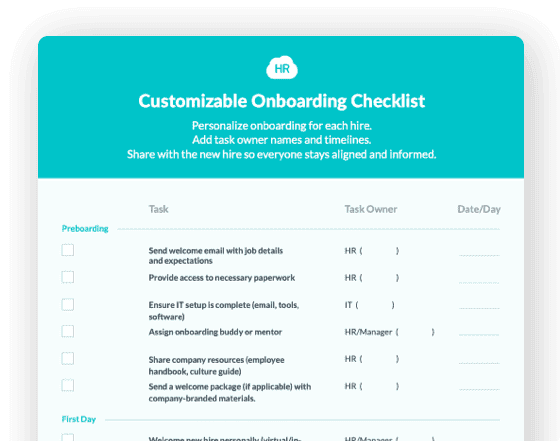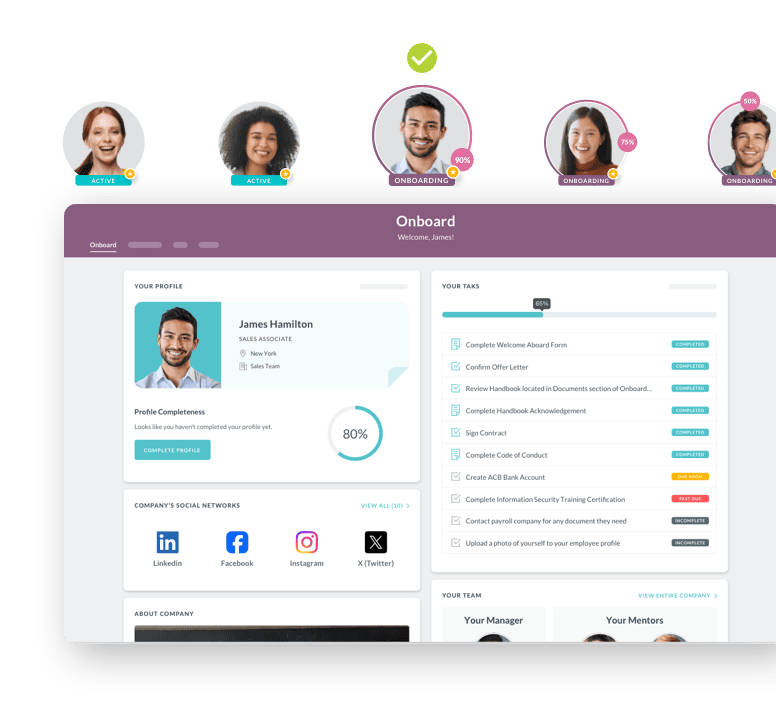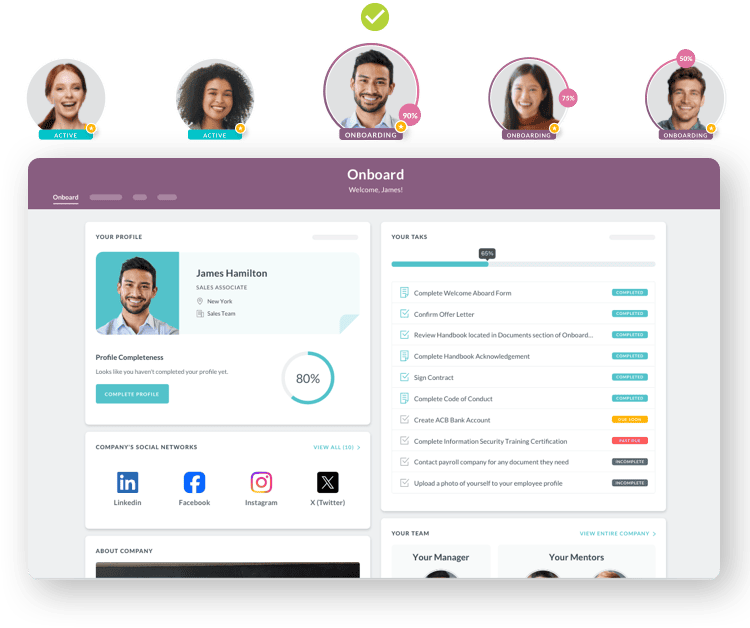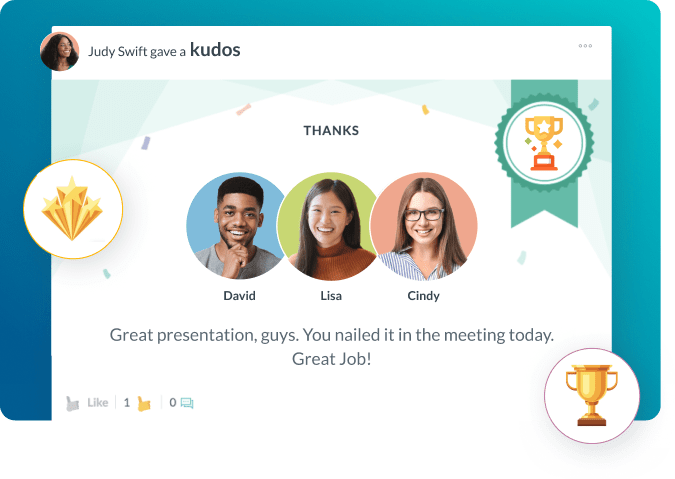Contingent Hiring
- Key Insights on Contingent Workforce Strategy
- Comparing Contingent and Permanent Workforce Models
- Implementing Effective Contingent Hiring Practices
- Critical Mistakes in Contingent Workforce Management
- How Industries Apply Contingent Hiring Models
- Building Your Contingent Hiring Program Step by Step
- Emerging Developments in Contingent Work

 Cut onboarding time
by 60%—here's the
Ultimate Checklist
that helped do it.
Cut onboarding time
by 60%—here's the
Ultimate Checklist
that helped do it.

Contingent hiring has evolved from a temporary staffing solution to a core business strategy. Organizations across industries now rely on this flexible approach to access specialized skills, manage costs, and respond quickly to market changes. Understanding how to effectively implement contingent hiring programs can give your business a significant competitive advantage in today's fast-paced economy.
Contingent hiring refers to the practice of engaging workers on a non-permanent basis to meet specific business needs. These workers include freelancers, independent contractors, consultants, temporary employees, and project-based professionals who provide services without becoming traditional full-time employees. Unlike permanent hires, contingent workers typically lack long-term job security and traditional employment benefits, but they offer organizations unprecedented flexibility and access to specialized expertise.
The shift toward contingent work arrangements reflects fundamental changes in how businesses operate. According to research from Harvard Business Review, almost all Fortune 500 firms now use talent platforms to access on-demand workers. The Bureau of Labor Statistics reports that contingent workers represent a growing segment of the American workforce, with organizations increasingly viewing these arrangements as permanent components of their talent strategies rather than temporary fixes.
Key Insights on Contingent Workforce Strategy
Before diving into implementation, you need to understand what makes contingent hiring different from traditional recruitment. This approach requires new thinking about talent acquisition strategies and workforce planning.
-
Contingent hiring provides immediate access to specialized skills without long-term commitments, allowing organizations to scale operations up or down based on project demands and market conditions.
-
Cost management improves significantly because businesses only pay for work completed rather than maintaining fixed salary expenses, benefits packages, and overhead costs associated with permanent employees.
-
Organizations can test potential permanent hires through contract-to-hire arrangements, reducing the risk of bad hiring decisions while evaluating cultural fit and performance in real work scenarios.
-
The speed of hiring accelerates dramatically because contingent workers often require minimal onboarding and can contribute immediately with their existing expertise and experience.
-
Businesses gain flexibility to pursue projects and opportunities they might otherwise decline due to capacity constraints or skill gaps in their permanent workforce.
-
Access to global talent pools expands exponentially through remote work arrangements and digital platforms, connecting organizations with specialized expertise regardless of geographic location.
Comparing Contingent and Permanent Workforce Models
|
Aspect |
Contingent Workers |
Permanent Employees |
|
Employment Duration |
Project-based, temporary, or contract term |
Ongoing, long-term commitment |
|
Benefits & Protections |
Typically excluded from health insurance, retirement plans, paid leave |
Full benefits package including insurance, PTO, retirement |
|
Cost Structure |
Pay only for services rendered, hourly or project-based |
Fixed salary plus benefits, ongoing overhead costs |
|
Onboarding Time |
Minimal, often immediate contribution |
Extended onboarding, training, and ramp-up period |
|
Flexibility |
High, can scale workforce quickly |
Limited, subject to employment contracts and regulations |
|
Skill Access |
Specialized expertise for specific needs |
Broad, well-rounded skills for diverse responsibilities |
|
Management Approach |
Client relationship, outcome-focused |
Supervisor relationship, process and performance-focused |
Implementing Effective Contingent Hiring Practices
Success with contingent hiring requires intentional strategies that differ from traditional employment approaches. Organizations must develop new systems and processes to maximize the value these workers provide.
Your first priority should be establishing clear classification criteria to distinguish between employees and independent contractors. Misclassification creates serious legal and financial risks, so consult employment law experts to ensure compliance with federal and state regulations. Document the business rationale for each contingent position to demonstrate that workers truly operate independently.
Create detailed project scopes and deliverables before engaging contingent workers. Vague assignments lead to confusion, scope creep, and disappointing results. Define specific outcomes, timelines, and success metrics upfront. This clarity benefits both your organization and the worker by establishing mutual expectations from day one.
Develop streamlined onboarding processes that get contingent workers productive quickly while protecting your business interests. Include essential compliance paperwork, system access protocols, intellectual property agreements, and confidentiality protections. Even temporary workers need proper orientation to your company culture, communication channels, and project context.
Build relationships with quality staffing agencies and talent platforms that understand your industry and business needs. These partnerships provide pre-vetted candidates, handle administrative burdens, and offer valuable market insights. Investing time in recruiting strategies pays dividends through better matches and faster placements.
Integrate contingent workers thoughtfully into your teams and projects. While they lack permanent status, excluding them from meetings, communications, and team activities undermines productivity and engagement. Create inclusive environments where contingent professionals feel valued and connected to broader organizational goals.
Monitor performance consistently through regular check-ins, progress reviews, and feedback sessions. Don't wait until projects end to address concerns or recognize exceptional work. Proactive management ensures quality outcomes and strengthens relationships with contingent talent you may want to engage again.


Critical Mistakes in Contingent Workforce Management
Even experienced organizations stumble when managing contingent workers. These common pitfalls can derail projects, create legal exposure, and waste valuable resources. Learning from these mistakes helps you avoid costly errors.
Many companies treat contingent workers exactly like employees in daily operations while maintaining they're independent contractors on paper. This creates worker misclassification risks that can result in penalties, back taxes, and benefit obligations. Maintain clear distinctions in how you supervise, direct, and integrate contingent versus permanent staff.
Neglecting proper contracts and agreements before work begins leads to disputes over deliverables, payment terms, intellectual property ownership, and liability. Never allow contingent work to start without signed agreements that protect both parties and clearly outline all terms, including termination conditions and dispute resolution processes.
Failing to plan for knowledge transfer and documentation when contingent workers leave creates operational disruptions and lost institutional knowledge. Require thorough documentation of work processes, decisions, and project status. Build in transition periods before contracts end to capture critical information and train permanent staff on systems or processes the contingent worker developed.
Overlooking the importance of workforce management systems to track contingent workers across departments leads to duplicate hiring, uncontrolled spending, and compliance blind spots. Implement centralized tracking for all contingent engagements, including hours worked, projects assigned, and total spending by worker and department.
Ignoring engagement and inclusion needs because workers are temporary creates poor morale, reduced productivity, and quality issues. While contingent workers understand their status differs from employees, they still need clear communication, appropriate resources, and respectful treatment to deliver their best work.
How Industries Apply Contingent Hiring Models
Contingent hiring strategies adapt to different industry contexts, with each sector leveraging these approaches to address specific challenges and opportunities.
Technology companies pioneered widespread use of contingent workers to access specialized programming languages, emerging technologies, and project-based development work. A software firm launching a mobile app might engage iOS and Android developers as contractors for the initial build, then transition to permanent employees for ongoing maintenance. This approach allows technology organizations to pursue cutting-edge projects without committing to permanent headcount in rapidly evolving specialties where skills become outdated quickly.
Healthcare organizations increasingly rely on contingent clinical staff to manage fluctuating patient volumes, seasonal illness patterns, and geographic coverage gaps. Hospitals hire traveling nurses through staffing agencies to cover shortages, staff new units, or replace employees on extended leave. This flexibility proves essential in an industry where demand varies unpredictably and permanent staffing decisions carry long-term financial implications.
Professional services firms use contingent consultants to scale delivery capacity for large client engagements without maintaining excess capacity during slower periods. A management consulting firm might bring in specialized industry experts or technical specialists for specific client projects, paying premium rates for expertise they need intermittently rather than keeping these expensive specialists on staff year-round.
Building Your Contingent Hiring Program Step by Step
Creating an effective contingent workforce program requires systematic planning and execution. Follow this roadmap to build a program that delivers strategic value while managing risks appropriately.
Start by conducting a thorough analysis of your current and projected workforce needs. Identify positions, projects, and skill areas where contingent hiring makes strategic sense. Consider seasonality patterns, project-based work, specialized expertise needs, and areas where you need flexibility to scale quickly. Document these findings in a strategic workforce plan that guides hiring decisions.
Develop clear policies and procedures that govern contingent worker engagement across your organization. Address classification standards, approval workflows, budget controls, contract templates, and performance management approaches. Create guidelines for managers about when to use contingent versus permanent workers. Ensure legal review of all policies to maintain compliance with employment laws.
Select and implement appropriate technology tools to manage your contingent workforce program. Depending on your scale, this might include vendor management systems, applicant tracking tools, or time and project tracking software. These systems provide visibility into spending, ensure consistent processes, and generate data for program evaluation and improvement.
Establish relationships with quality staffing partners, talent platforms, and specialized recruiters who understand your needs. Vet these partners carefully, checking references and reviewing their screening, compliance, and candidate quality processes. Negotiate favorable terms while recognizing that quality vendors command fair compensation for their services and expertise.
Train hiring managers and supervisors on proper contingent worker management, including effective hiring practices, classification requirements, performance expectations, and relationship boundaries. Many managers lack experience with contingent workers and need guidance on legal requirements and best practices.
Launch pilot programs in select departments before rolling out company-wide contingent hiring initiatives. Monitor these pilots closely, gather feedback from managers and workers, and refine your processes based on real-world experience. Use pilot results to build buy-in and demonstrate value to skeptical stakeholders.
Measure program performance through key metrics including time to fill positions, cost per engagement, quality of work delivered, manager satisfaction, and compliance incident rates. Regular measurement allows continuous improvement and helps justify program investments to senior leadership.
Emerging Developments in Contingent Work
The contingent workforce landscape continues evolving rapidly, driven by technology advances, changing worker preferences, and economic pressures. Organizations that anticipate these shifts can position themselves advantageously.
Artificial intelligence and automation are transforming how companies find, evaluate, and manage contingent talent. AI-powered platforms now match workers to opportunities based on skills, availability, and past performance with unprecedented speed and accuracy. These tools reduce hiring cycle times while improving match quality, making contingent hiring even more attractive for organizations seeking agility.
Skills-based hiring is replacing credential-focused approaches across the contingent workforce. Rather than requiring specific degrees or years of experience, forward-thinking organizations assess candidates based on demonstrated capabilities through skills assessments, portfolio reviews, and practical evaluations. This shift expands available talent pools while focusing on what truly predicts success in specific roles.
Portable benefits models are emerging to address the lack of traditional employment benefits for contingent workers. Some platforms now offer access to health insurance, retirement accounts, and other protections that follow workers across multiple engagements. This evolution may make contingent work more attractive to a broader range of professionals while addressing longstanding equity concerns.
Blended workforce strategies that seamlessly integrate permanent and contingent workers are becoming the norm rather than the exception. Organizations are moving beyond viewing these as separate talent pools toward holistic workforce planning that deploys the right mix of workers for each business need. This requires new management approaches, technology systems, and cultural shifts to create truly inclusive environments.
Global talent access continues expanding as remote work becomes permanent for many roles. Geography no longer constrains hiring decisions, allowing organizations to access specialized expertise anywhere in the world. This globalization of contingent work creates both opportunities for businesses and challenges around time zones, cultural differences, and compliance with international employment regulations.
Regulatory environments are evolving in response to the growth of contingent work. Lawmakers and regulators are examining worker classification standards, benefit portability, and protections for non-traditional workers. Organizations must stay informed about compliance requirements and adapt their programs as regulations change.
The future belongs to organizations that master contingent workforce strategies. By understanding these emerging trends and building flexible, compliant programs, you position your business to access the best talent, control costs effectively, and respond quickly to market opportunities. Start planning your contingent hiring strategy today to stay competitive in tomorrow's dynamic business environment.
Keep Reading
Credential Tracking in Healthcare: How to Automate License Renewals and Stay Audit-Ready
A nurse shows up ready for her shift but her license expired yesterday. You scramble for
Onboarding 500 Nurses a Year: Lessons from High-Volume Hospital HR Teams
Hiring 5 nurses can be done off-the-cuff. But hiring 500 is a logistics operation by
AI for Frontline HR: Moving Beyond Sentiment Analysis to Build Tomorrow's Workforce Management Engine
TL;DR: While most organizations limit artificial intelligence in human resources to basic
Ready to streamline your onboarding process?
Book a demo today and see how HR Cloud can help you create an exceptional experience for your new employees.







